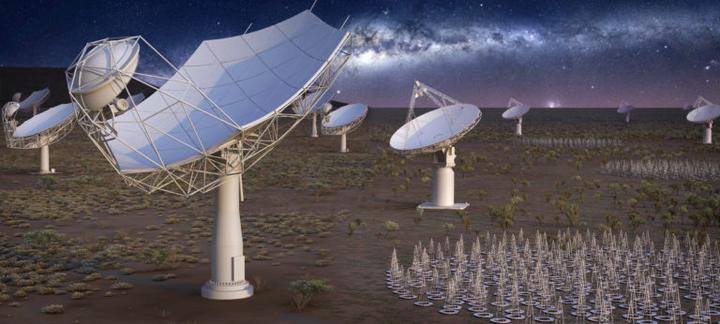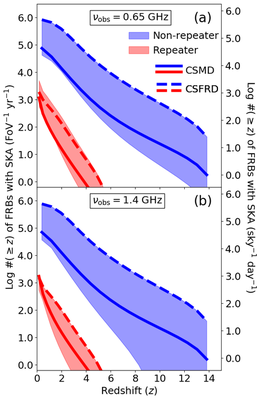 Image credit: [The Square Kilometre Array]
Image credit: [The Square Kilometre Array]
Fast radio bursts (FRBs) are mysterious radio signals emitted from extra-galaxies. Revealing their origin(s) is one of the central foci in the transient astronomy. They are also thought to be useful to address the cosmic reionization history and dark energy, i.e., the biggest phase transition of the early Universe from neutral to ionized states and the mysterious energy driving an accelerated expansion of the Universe, respectively. For these purposes, abundant FRBs are necessary, although the number of detected FRBs is only ~100 to date. Therefore, a new telescope to find FRBs is awaited.
The Square Kilometre Array (SKA) is the one of the best future instruments to address these subjects. The SKA will start its science operation in 2020s. Currently many researchers pay attention to the number of FRBs to be detected with the SKA. Here, I predict the number of FRBs in the SKA era using FRB luminosity functions (number density of FRBs as a function of their luminosity) derived in my previous work.

I found that 10^5-10^6 extragalactic FRBs will be detected with the SKA per year (Figure). At the reionization epoch of the Universe, 10^2-10^4 (10-10^3) FRBs will be detected at redshift higher than 6 (10) per year. These numbers are much higher than the current FRB sample, indicating that the SKA will provide a breakthrough in finding FRBs in near future. I expect that these numbers of FRBs are large enough to address (i) the origin of FRBs, (ii) the cosmic reionization history, and (iii) the mysterious dark energy.
This project is based on the following publication.
Tetsuya Hashimoto, Tomotsugu Goto, Alvina Y. L. On, Ting-Yi Lu, Daryl Joe D. Santos, Simon C.-C. Ho, Ting-Wen Wang, Seong Jin Kim, and Tiger Y.-Y. Hsiao, 'Fast radio bursts to be detected with the Square Kilometre Array' , accepted for publication in Monthly Notices of the Royal Astronomical Society, (2020).
This paper was featured by astrobites, 'Focusing Squarely on FRBs with the Square Kilometre Array'.